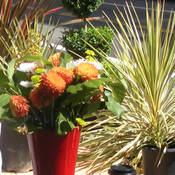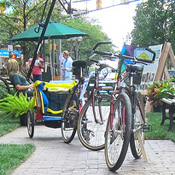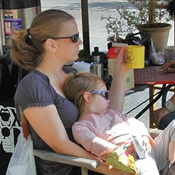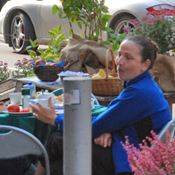Worldwide
Background
PARK(ing) Day provides temporary public open space—one parking spot at a time. During this annual global event, citizens, artists and activists collaborate to temporarily transform metered parking spaces into temporary public places. The project began in 2005 when Rebar, a San Francisco art and design studio, converted a single metered parking space into a temporary public park in downtown San Francisco. Since 2005, PARK(ing) Day has evolved into a global movement. PARK(ing) Day is a noncommercial project, promoting creativity, civic engagement, critical thinking, social interactions, generosity and play.
PARK(ing) Day calls attention to the need for more urban open space, generates critical debate around how public space is created and allocated, and improves the quality of urban human habitat. In our urban environments, the great majority of downtown outdoor space is dedicated to movement and storage of private vehicles while only a fraction of that space is allocated to serve a broader range of public needs. Paying the meter of a parking space enables one to lease precious urban real estate on a short-term basis. The PARK(ing) project explores the range of possible activities for this short-term lease and provokes a critical examination of the values that generate the urban form.
PARK(ing) Day has since been adapted and remixed to address a variety of social issues in diverse urban contexts and places. The project continues to expand to include interventions and experiments well beyond the first basic “tree-bench-sod” park typology. Participants have built free health clinics, planted temporary urban farms, produced ecology demonstrations, held political seminars, built art installations, opened free bike repair shops and even held a wedding ceremony — all within a metered parking space! Organizers also have used the event to draw attention to issues that are important to their local public — everything from experimentation and play to acts of generosity and kindness, to political issues such as water rights, labor equity, and health care and marriage equality.
In 2011, the event included over 850 PARKs in more than 180 cities across the world. Just in Philadelphia, there were more than 30 spots in 2011. Participants are asked to map their PARK(ing) space on the PARK(ing) Day website, www.parkingday.org. The website also serves as a link to others in local communities who are interested in hosting a Park(ing) Day and provides resources for organizing a local event. The event is typically held on a Friday to attract the greatest public attention.
The legality of PARK(ing) Day varies from community to community. Although, no one has been arrested for participating in PARK(ing) Day, some PARKS have been shut down by authorities. Maintaining an attitude of community service, generosity and inclusion has been shown to help assuage the concerns of local authorities. It also helps to inform law enforcement of intentions to leave the parking spot in a better/cleaner condition than when it was found.
Lessons Learned
Potential Benefits:
- Promote creativity, civic engagement, critical thinking, social interactions, and play.
- Call attention to the need for more urban open space.
- Provide a temporary place for free health clinics, temporary urban farms, ecology demonstrations, political seminars, art installations, free bike repair shops, and even a wedding ceremony.
- Draw attention to issues that are important to the local public, such as water rights, labor equity, health care and marriage equality.
- Help transition to more affective use of street ROW for pedestrians and non-private automobile users of the street.
Potential Issues:
- Legal and Liability Concerns: The legal and liability specifics depend on the local legal codes and it becomes the responsibility of the Park(ing) day participant to check and obey the law. For example, in San Francisco it appears to be legal to do other things in a parking spot besides park a vehicle, but in some municipalities (New York City, for example) alternate activities are expressly prohibited. It’s up to you to be informed and flexible when it comes to obeying your local law.
- Maintenance: Part of the legal and liability concerns is the intention of the Park(ing) day participant to leave the parking spot in a better/cleaner condition. Usually, this has been addressed by past participants maintaining an attitude of community service, generosity and inclusion has helped assuage the concerns of local authorities. Participants also try to inform any law enforcement official about their intention to leave the parking spot in a better/cleaner condition than before. Some participants have been known to not just clean up after themselves, but also sweep the whole block!
Sources
Park(ing) Day (http://parkingday.org/)
http://www.parkingdayphila.org/
http://sf.streetsblog.org/2011/09/16/parking-day-2011in-san-francisco-time-to-reclaim-the-streets/
Photo Sources
MIG




